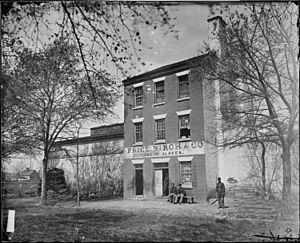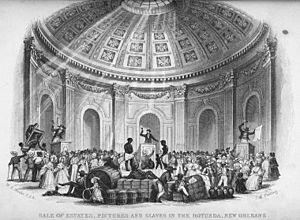Slave pen facts for kids
A slave pen or slave jail was a place where enslaved people were held for a short time. They stayed there until they were sold, or after they were sold while waiting for travel arrangements. Some slave pens were also like depots, located along the routes from slave markets to where people were finally taken.
Contents
What Were Slave Pens?
Slave pens were used for many decades before the American Civil War. They held people until they were sold at slave markets. These places were known for harsh treatment and deep sadness. Slave traders often separated families, taking husbands from wives and children from their parents.
Slave pens were important in the business of selling enslaved African Americans. This was common in Virginia and Maryland. When growing tobacco became less profitable, plantation owners started growing other crops that needed fewer workers. This meant more enslaved people were available for traders to sell.
The Slave Trade Journey
Arrival at the Pen
Slave traders would visit plantations to buy enslaved people. Sometimes, slave owners also brought their workers to the market. These individuals were then kept in slave pens, usually located close to the slave markets.
New Orleans was the biggest center for slave trading. Richmond, Virginia was the second largest. Charleston, South Carolina was the main place for receiving enslaved people from Africa. However, in 1808, a law was passed that stopped the import of enslaved people from the West Indies and Africa.
Life Inside a Slave Pen
Enslaved people were kept in pens while they waited to be sold. These pens could become very crowded, especially on sale days. In New Orleans, most sales happened between September and May. Buyers would visit the slave pen to inspect the enslaved people before the sale.
Lumpkin's Jail, the largest slave pen in Virginia, was a particularly difficult place. People sometimes suffered from hunger, sickness, or beatings there. The pens were so cramped that people were often on top of one another. There were also no proper bathrooms.
Leaving the Pen

People stayed in the pens until their travel was arranged. They were moved in groups by boat, walked to their new owners, or a mix of both. When walking, they were often moved in a coffle. This meant people were chained together with iron rings around their necks. These rings were fastened with wooden or iron bars. Men on horseback would guide these groups, using dogs, guns, and whips.
Later, railroads offered a simpler way to travel, which meant coffles were used less often. Some slave traders, like Franklin & Armfield, had a network of slave-depots along their routes.
Slave Pens After the Civil War
During the American Civil War, some slave pens were used by the Union Army to hold Confederate soldiers. For example, pens in St. Louis, Missouri and Alexandria, Virginia were used this way. In Natchez, Mississippi, the Forks of the Road Market slave market was used by Union soldiers to give protection and freedom to African Americans. In 2021, this site became part of the Natchez National Historical Park.
Old slave pens were also used for new purposes, like places of worship. In Lexington, Kentucky, Lewis Robard's slave jail became a Congregational church for African Americans. A seminary for Black students, now Virginia Union University, was started in Lumpkin's Jail. This place was once known as the "devil's half acre." A founder of the seminary, James B. Simmons, said it would now be "God's half acre."
These pens were also used for schools, which was a big change because enslaved people were not allowed to learn to read or write. In December 1864, a white person saw the former Savannah, Georgia slave market being used for education and helping African Americans. They described it:
I passed up the two flights of stairs down which thousands of slaves had been dragged, chained in coffle, and entered a large hall. At the farther end was an elevated platform about eight feet square,—the auctioneer's block. The windows were grated with iron. In an anteroom at the right women had been stripped and exposed to the gaze of brutal men.



